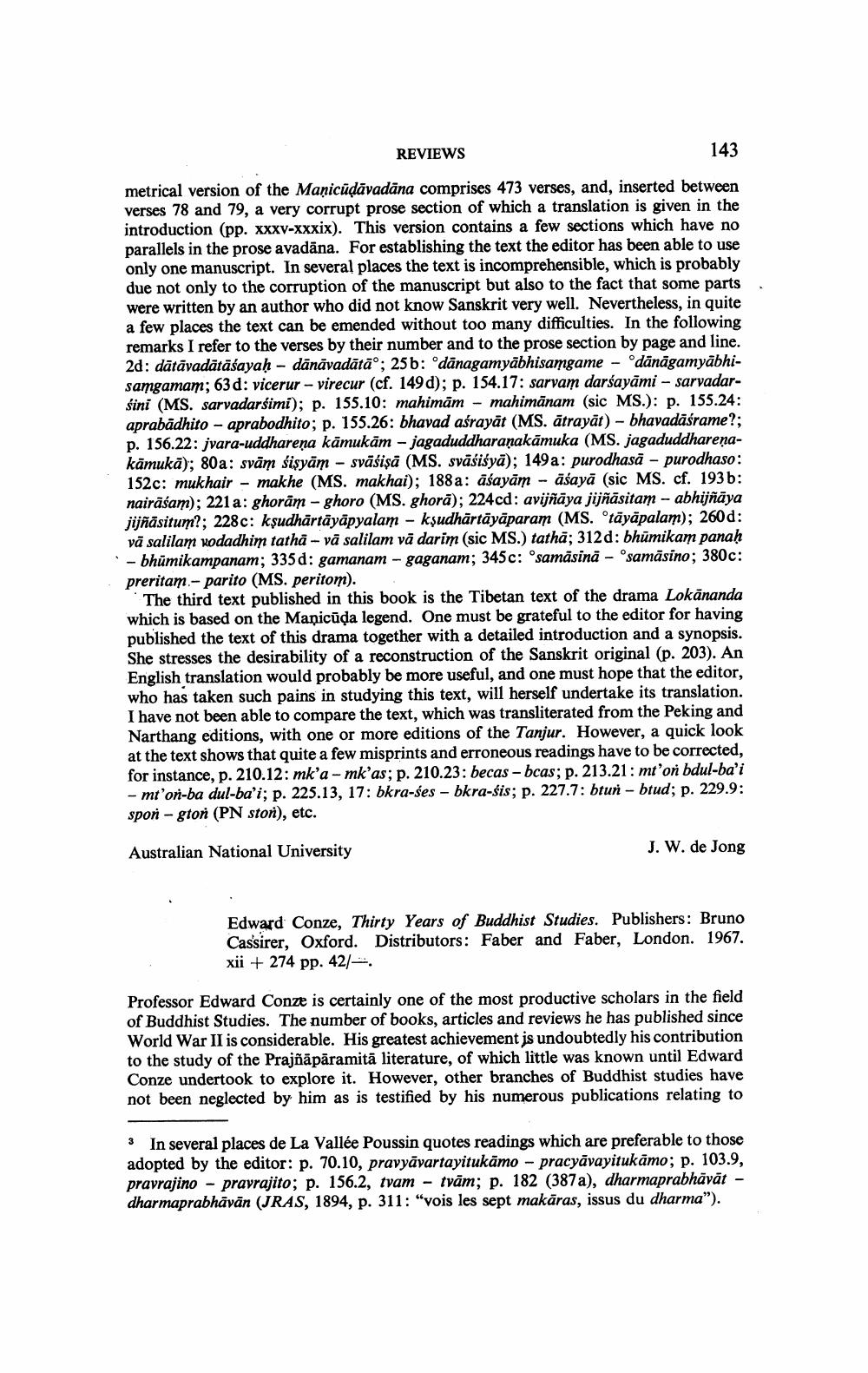Book Title: Reviews Of Different Books Author(s): Publisher: View full book textPage 7
________________ REVIEWS 143 metrical version of the Manicudavadana comprises 473 verses, and, inserted between verses 78 and 79, a very corrupt prose section of which a translation is given in the introduction (pp. XXXV-Xxxix). This version contains a few sections which have no parallels in the prose avadana. For establishing the text the editor has been able to use only one manuscript. In several places the text is incomprehensible, which is probably due not only to the corruption of the manuscript but also to the fact that some parts were written by an author who did not know Sanskrit very well. Nevertheless, in quite a few places the text can be emended without too many difficulties. In the following remarks I refer to the verses by their number and to the prose section by page and line. 2d: datavadatasayah - danavadatadeg; 25b: odanagamyabhisamgame - odanagamyabhisamgamam; 63d: vicerur - virecur (cf. 149d); p. 154.17: sarvam darsayami - sarvadarsini (MS. sarvadarsimi); p. 155.10: mahimam - mahimanam (sic MS.): p. 155.24: aprabadhito - aprabodhito; p. 155.26: bhavad asrayat (MS. atrayat) - bhavadasrame?; p. 156.22: jvara-uddharena kamukam - jagaduddharanakamuka (MS. jagaduddharenakamuka); 80a: svam sisyam - svasisa (MS. svasisya); 149a: purodhasa - purodhaso: 152c: mukhair - makhe (MS. makhai); 188a: asayam - asaya (sic MS. cf. 193b: nairasam); 221 a: ghoram - ghoro (MS. ghora); 224cd: avijnaya jijnasitam - abhijnaya jijnasitum?; 228c: ksudhartayapyalam - ksudhartayaparam (MS. degtayapalam); 260d: va salilam rodadhim tatha - va salilam va darim (sic MS.) tatha; 312d: bhumikam panah - bhumikampanam; 335d: gamanam - gaganam; 345c: osamasina - samasino; 380c: preritam.- parito (MS. peritom). The third text published in this book is the Tibetan text of the drama Lokananda which is based on the Manicuda legend. One must be grateful to the editor for having published the text of this drama together with a detailed introduction and a synopsis. She stresses the desirability of a reconstruction of the Sanskrit original (p. 203). An English translation would probably be more useful, and one must hope that the editor, who has taken such pains in studying this text, will herself undertake its translation. I have not been able to compare the text, which was transliterated from the Peking and Narthang editions, with one or more editions of the Tanjur. However, a quick look at the text shows that quite a few misprints and erroneous readings have to be corrected, for instance, p. 210.12: mk'a - mk'as; p. 210.23: becas - bcas; p. 213.21: mt'on bdul-ba'i - mt'or-ba dul-ba'i; p. 225.13, 17: bkra-ses - bkra-sis; p. 227.7: btun - btud; p. 229.9: spon - gton (PN ston), etc. Australian National University J. W. de Jong Edward Conze, Thirty Years of Buddhist Studies. Publishers: Bruno Cassirer, Oxford. Distributors: Faber and Faber, London. 1967. xii + 274 pp. 42/. Professor Edward Conze is certainly one of the most productive scholars in the field of Buddhist Studies. The number of books, articles and reviews he has published since World War II is considerable. His greatest achievement is undoubtedly his contribution to the study of the Prajnaparamita literature, of which little was known until Edward Conze undertook to explore it. However, other branches of Buddhist studies have not been neglected by him as is testified by his numerous publications relating to 3 In several places de La Vallee Poussin quotes readings which are preferable to those by the editor: p. 70.10, pravyavartayitukamo - pracyavayitukamo; p. 103.9, pravrajino - pravrajito; p. 156.2, tvam - tvam; p. 182 (387a), dharmaprabhavat - dharmaprabhavan (JRAS, 1894, p. 311: "vois les sept makaras, issus du dharma").Page Navigation
1 ... 5 6 7 8 9 10 11 12 13 14 15
